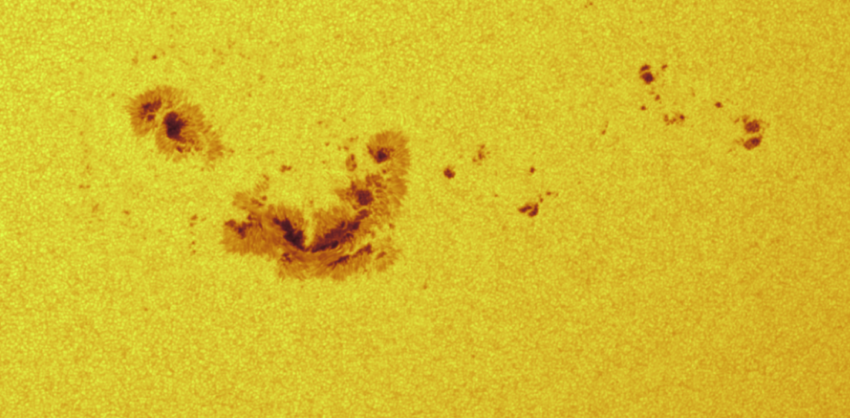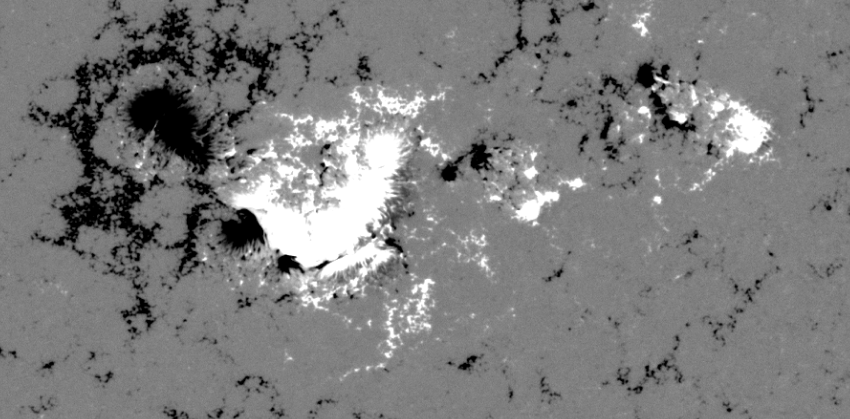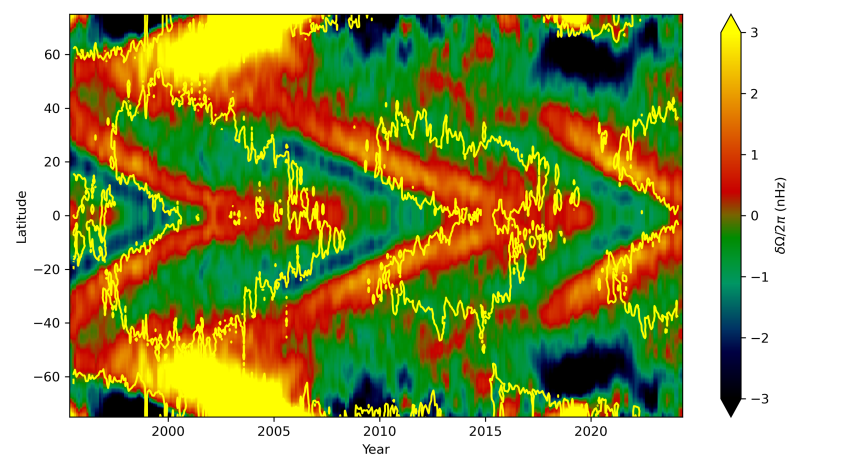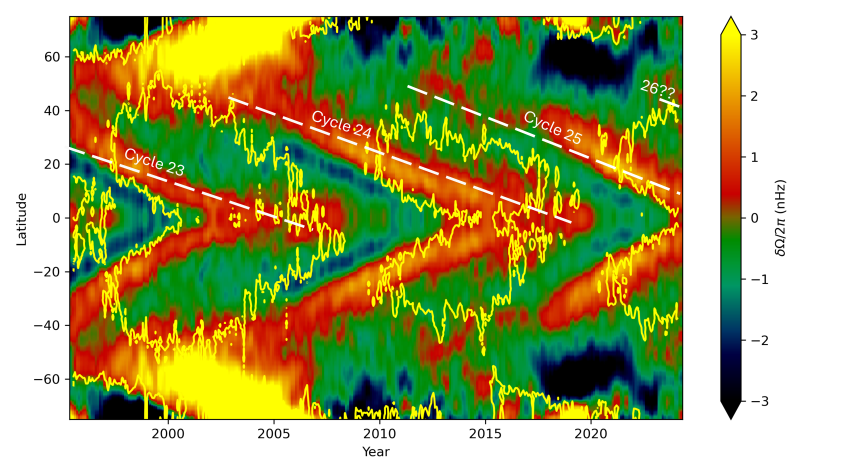The first rumblings of the Sun's next 11-year solar cycle have been detected in sound waves inside our home star – even though it is only halfway through its current one.
This existing cycle is now at its peak, or 'solar maximum' - which is when the Sun’s magnetic field flips and its poles swap places - until mid-2025.
It affects activity on the Sun's surface, with sunspots, flares and coronal mass ejections all more rampant at solar maximum. This leads to a surge in electromagnetic energy hurtling towards the Earth and makes aurorae visible more often and at lower altitudes.
The current solar cycle, named Cycle 25 because it is the 25th since 1755 when extensive recording of solar sunspot activity began, started in 2019.
It is not expected to end for another six years but the first signs that the next solar cycle is beginning have been spotted by researchers from the University of Birmingham and presented at the Royal Astronomical Society's National Astronomy Meeting in Hull.
Astronomers use the Sun's internal sound waves to measure how it rotates, making visible a pattern of bands (solar torsional oscillation) that rotate slightly faster or slower. These move towards the Sun's equator and its poles during the activity cycle.
The faster-rotation belts tend to show up before the next solar cycle officially begins.
Dr Rachel Howe and her international collaborators have discovered a faint indication that the next solar cycle is starting to show up in the data they have been analysing from the rotation bands.
"If you go back one solar cycle - 11 years - on the plot, you can see something similar that seems to join up with the shape that we saw in 2017. It went on to be a feature of the present solar cycle, Cycle 25," said Dr Howe, a research fellow at the University of Birmingham.
"We're likely seeing the first traces of Cycle 26, which won't officially start until about 2030."
Solar torsional oscillation signals have been studied using helioseismic data from the Global Oscillation Network Group (GONG), the Michelson Doppler Imager (MDI) onboard the Solar and Heliospheric Observatory, and the Helioseismic and Magnetic Imager (HMI) on board the Solar Dynamics Observatory since 1995.
The data now covers the first four years of Solar Cycles 23, 24 and 25, allowing researchers to compare the rising phases of these cycles.
Dr Howe has been following the changes in the Sun's rotation for about 25 years, when scientists only had a portion of data from Solar Cycle 23 from GONG and MDI.
They could see the pattern of faster-moving material drifting towards the equator along with the sunspots. Since then, they have watched the pattern repeat (but not exactly) as Cycle 24 came and went and again as Cycle 25 grew.
"It's exciting to see the first hint that the pattern will repeat again in Cycle 26, which is due to start in about six years.
"With more data, I hope we can understand more about the part these flows play in the intricate dance of plasma and magnetic fields that form the solar cycle," she said.
Media contacts
Sam Tonkin
Royal Astronomical Society
Mob: +44 (0)7802 877 700
Dr Robert Massey
Royal Astronomical Society
Mob: +44 (0)7802 877 699
Megan Eaves
Royal Astronomical Society
Science contacts
Dr Rachel Howe
University of Birmingham
Images and captions
Caption: Helioseismic and Magnetic Imager (HMI) image of the big sunspot that occurred on 5 May 2024, in continuum intensity ('white light').
Credit: NASA/SDO and HMI science team
Caption: Helioseismic and Magnetic Imager (HMI) image of the big sunspot that occurred on 5 May 2024, in magnetic field.
Credit: NASA/SDO and HMI science team
Caption: This map shows which latitudes on the Sun were rotating faster (shown in red and yellow) or slower (shown in blue and green) than average over the last 29 years, as inferred by helioseismology (the analysis of solar sound waves). For each solar cycle, there is a band of faster rotation that moves down towards the equator. The yellow lines show the areas where the magnetic fields are most concentrated.
Credit: Rachel Howe
Caption: It is possible to see the whole of Solar Cycles 23 and 24, and the first half of Cycle 25. For each cycle, the band of faster rotation starts well before the magnetic activity for that cycle. On the far right of the figure, a bit of red marks what the team believes is the beginning of the fast-rotating band for Cycle 26.
Credit: Rachel Howe
Further information
Deployed in 1995, the Global Oscillation Network Group (GONG) is a global network of six identical telescopes, designed to have 24/7 observations of the Sun for use in space weather prediction and study of the Sun. The six observatories are the Teide Observatory (Canary Islands), the Learmonth Solar Observatory (Western Australia), the Big Bear Solar Observatory (California), the Mauna Loa Observatory (Hawaii), the Udaipur Solar Observatory (India) and the Cerro Tololo Inter-American Observatory (Chile).
Launched in 1995, the Solar & Heliospheric Observatory is an international collaboration between ESA and NASA to study the Sun from its deep core to the outer corona and the solar wind. Mission control is run by NASA at Goddard Space Flight Center in Maryland, US.
The Solar Dynamics Observatory is a NASA mission launched in February 2010 as part of the Living With a Star programme. Its focus is on solar activity, particularly observing the Sun's magnetic field.
Notes for editors
The NAM 2024 conference is principally sponsored by the Royal Astronomical Society, the Science and Technology Facilities Council and the University of Hull.
About the Royal Astronomical Society
The Royal Astronomical Society (RAS), founded in 1820, encourages and promotes the study of astronomy, solar-system science, geophysics and closely related branches of science.
The RAS organises scientific meetings, publishes international research and review journals, recognises outstanding achievements by the award of medals and prizes, maintains an extensive library, supports education through grants and outreach activities and represents UK astronomy nationally and internationally. Its more than 4,000 members (Fellows), a third based overseas, include scientific researchers in universities, observatories and laboratories as well as historians of astronomy and others.
The RAS accepts papers for its journals based on the principle of peer review, in which fellow experts on the editorial boards accept the paper as worth considering. The Society issues press releases based on a similar principle, but the organisations and scientists concerned have overall responsibility for their content.
Keep up with the RAS on X, Facebook, LinkedIn and YouTube.
About the Science and Technology Facilities Council
The Science and Technology Facilities Council (STFC) is part of UK Research and Innovation – the UK body which works in partnership with universities, research organisations, businesses, charities, and government to create the best possible environment for research and innovation to flourish.
STFC funds and supports research in particle and nuclear physics, astronomy, gravitational research and astrophysics, and space science and also operates a network of five national laboratories, including the Rutherford Appleton Laboratory and the Daresbury Laboratory, as well as supporting UK research at a number of international research facilities including CERN, FERMILAB, the ESO telescopes in Chile and many more.
STFC's Astronomy and Space Science programme provides support for a wide range of facilities, research groups and individuals in order to investigate some of the highest priority questions in astrophysics, cosmology and solar system science.
STFC's astronomy and space science programme is delivered through grant funding for research activities, and also through support of technical activities at STFC's UK Astronomy Technology Centre and RAL Space at the Rutherford Appleton Laboratory. STFC also supports UK astronomy through the international European Southern Observatory and the Square Kilometre Array Organisation.
Visit https://stfc.ukri.org/ for more information. Follow STFC on Twitter: @STFC_Matters
About the University of Hull’s E.A. Milne Centre
The E.A. Milne Centre for Astrophysics at the University of Hull brings together experts who study the evolution of structure in the Universe ranging from stars through to galaxies and galaxy clusters, right up to the largest structures in the cosmos.
The centre employs observations, theory and computational methods in collaboration with international partners. Postgraduate and undergraduate students work alongside staff to understand the wonders of the Universe. Through a series of outreach activities, the centre also aims to share its passion for astronomy and astrophysics with the region and beyond.





